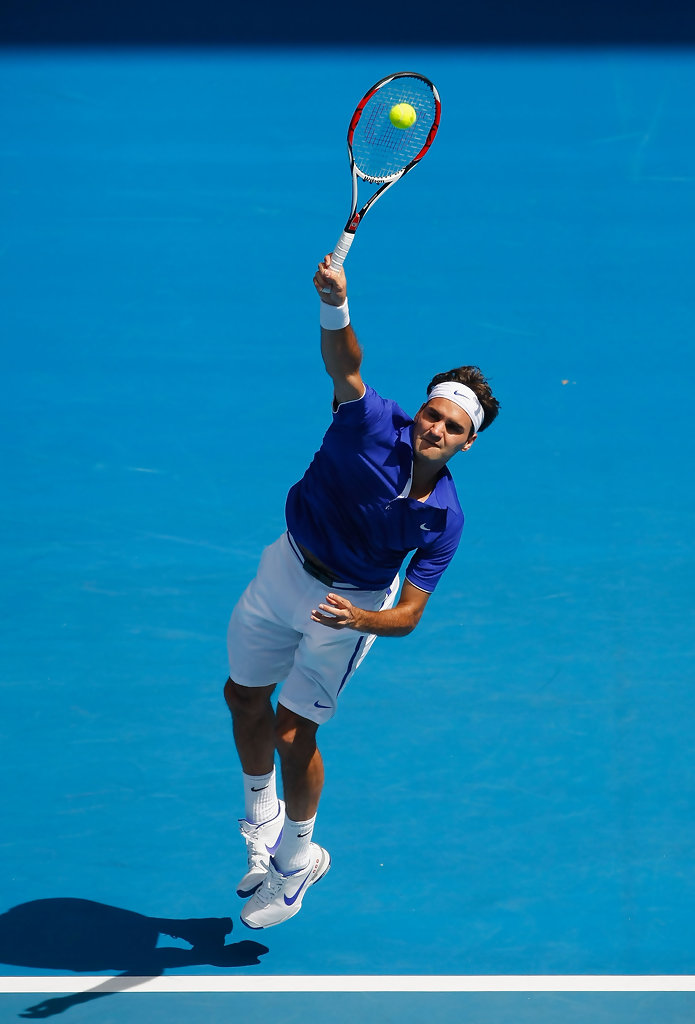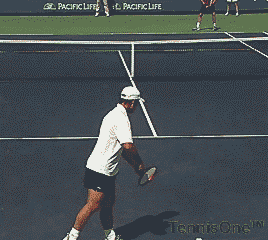Here is Rod Cross's TW University article on the kick serve.
The Physics of the Kick Serve, Rod Cross
http://twu.tennis-warehouse.com/learning_center/kickserve.php
(Information is mentioned here and there throughout this article, if you find something interesting, make a record of where it is.)
1) Closed Tilt on the Kick Serve Racket Face Tilt. In the abstract Cross states
"
In addition, it helps to strike the ball with the racquet head tilted forward slightly. "
I measured one Stosur serve at 13 degrees closed just before impact. The usual flat and slices are racket face tilt around 0 degrees at impact. I posted the Topspin Tennis video in post #64 showing Federer's kick and I have posted another video of Federer's kick serve with closed racket tilt.
I have seen enough video evidence myself to believe that the racket face is closed by around 13-15 degrees just before impact. I'll continue to find video evidence on the closed tilt of the racket face for the kick serve. The only video evidence that has been presented has shown the racket face closed at impact much more than for the slice and flat serves.
The question is - if you do not have this closed racket face can you ever hit a high level kick serve?
For video evidence and discussions
Search forum -
racket face closed tilt kick serve Chas
2) Does the Spin Vector Direction Stay the Same as the Ball Flies to the Bounce? Below is a quote of Cross's on the spin vector direction as the ball approaches the net. In videos, I have seen the print on the ball appear not to change spin orientations over 3-4 rotations. This is an extremely important point for the spin vector during the ball's flight to the serve bounce. It gives you the spin vector for the bounce in the coordinate system using vertical and the court line directions, as discussed in earlier posts.
I found Cross's comment on the spin direction of the kick serve as it approaches the net. From Physics of the Kick Serve.
"4. INTERPRETATION OF SPIN
Measurement of spin rates from high speed video film is relatively easy. The spin axis remains fixed while the ball travels toward the net, so the time for one revolution can be measured in terms of the number of video frames required for a particular mark or pattern on the ball to re-appear in the same orientation."
I accept that by Cross as the most creditable information that the forum has on the spin vector direction during flight. Anyone one of us with two video cameras could video the spin vector direction after racket impact and then again on the other side of the court and determine what is true. (Maybe it requires high speed video cameras.) Probably some of us have seen top spin forehand drives and the ball print reappearing as it flies. A sharpie could be used to make a larger and more visible mark on the ball.
It tells us the direction of the spin vector at bounce.
The Principle of Gyroscopic Rotation and the Football Pass. We would like to have a similar video for the spin vector of a tennis ball, we are already certain the tennis ball has a Gyroscopic effect because it is spinning.
3) Racket Rise.
from
Physics of the Kick Serve -
"
One of the mysteries concerning the kick serve is how the server manages to generate topspin in the first place. In order to achieve a good kick serve, the racquet head needs to rise up the back of the ball, as it does in a topspin groundstroke. To return a groundstroke with topspin, players normally swing the racquet upwards at an angle of about 30 degrees to the horizontal. That way, an upwards friction force is exerted on the back of the ball, causing the ball to rotate with topspin if the racquet is swung fast enough. The incoming ball bounces off the court with topspin, so the spin direction needs to be reversed in order to return the ball with topspin. In a serve the racquet head is almost at the top of its trajectory when it strikes the ball, so the racquet is rising at an angle of only a few degrees just before it strikes the ball. Therein lies the mystery. If the racquet needs to rise at 30 degrees to hit a good topspin forehand, how can anyone serve a ball with a significant amount of topspin when the racquet head is rising at only a few degrees?"
To single frame on Vimeo hold down the SHIFT KEY and use the ARROW KEYS. The top video may skip frames when the arrow key is used.
240 fps
For this kick serve technique, during impact there does not appear to be any racket head upward motion due to jumping.
A better confirmation of the kick serve bounce, with a second video camera is needed in future experiments.
There may also be more than one kick serve technique out there. ?
Observe current ATP player's kick serves.
@SystemicAnomaly and
@Dragy
Do you have a true or false opinion on any of the above three issues?






